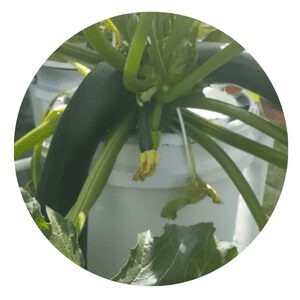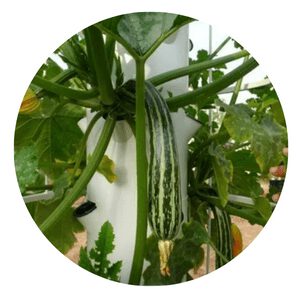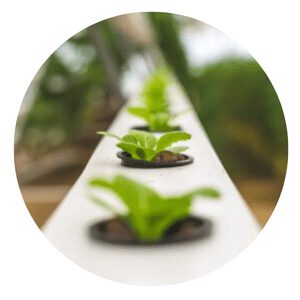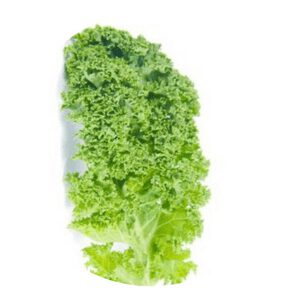How To Grow Squash Hydroponically
Squash is a popular vegetable to grow hydroponically because it is relatively easy to do so.
There are several types of squash, including zucchini, pumpkin, and yellow summer squash.
To grow squash hydroponically, you will need to purchase a hydroponic system, grow lights, and squash seeds.
You will also need to provide the proper nutrients for the plants.

Hydroponic Squash Menu
What is hydroponics?
Hydroponics is a method of growing plants in water without soil.
The roots of the plant are submerged in a nutrient-rich solution, and the plant is supported by a grow medium, such as gravel or clay pellets.
Hydroponics is a popular form of gardening among hobbyists and commercial growers alike, as it allows for high yields with minimal effort.
The benefits of growing squash hydroponically
If you love squash but don’t have the space for a garden, or if you want to grow squash year-round, hydroponic squash is a great option.
Hydroponics is a method of growing plants without soil, using only water and nutrients.
There are many benefits to growing squash hydroponically.
First, it is a very efficient way to use water and nutrients.
Second, there is no need for tilling or weeding, and pests are less of a problem.
Third, plants can be grown closer together, so you can get more squash per square foot.
If you’re interested in trying hydroponic squash, it’s easy to get started.
You’ll need a container with drainage holes, an air pump and stone diffuser, some net pots and grow media, and of course, seeds or seedlings.
Grow squash hydroponically and you'll never have to worry about pests or soil-borne diseases again. This method is clean and efficient, using only water and nutrients to produce healthy, bountiful plants. So give it a try - you may be surprised at how simple and rewarding it can be!
Chappy The Gardener
The best squash varieties for hydroponic systems
If you’re looking to add squash to your hydroponic system, you may be wondering what the best varieties are.
Here are some of the best squash varieties for hydroponics:
1. Zucchini: Zucchini is a versatile summer squash that can be used in a variety of dishes. It’s also relatively easy to grow hydroponically.
2. Yellow Squash: Yellow squash is another versatile variety that’s perfect forhydroponics. It has a slightly sweeter flavor than zucchini and is also great for roasting or grilling.
3. Pumpkins: Pumpkins are a classic fall favorite and make great additions tohydroponic systems. They’re perfect for carving or using as decoration, and can also be used in pies or other desserts.
The different types of hydroponic systems
If you’re interested in growing squash hydroponically, you should know that there are several different types of hydroponic systems you can use.
Each type has its own benefits and drawbacks, so it’s important to choose the right system for your needs.
The most common type of hydroponic system is the nutrient film technique (NFT).
This system uses a thin film of nutrient-rich water to feed the roots of the plants.
NFT is a very efficient system, but it can be difficult to control the environment and keep the roots healthy.
Another popular option is the drip irrigation system.
This system uses a series of drippers to slowly drip water and nutrients onto the roots of the plants.
Drip irrigation is easy to set up and maintain, but it can be expensive if you need to purchase a lot of equipment.
How to set up a squash hydroponic system
If you’re interested in growing squash hydroponically, there are a few things you need to know.
First, you’ll need to set up a hydroponic system. This can be done easily and cheaply with a few supplies from your local hardware store.
Second, you’ll need to choose the right variety of squash for your system.
Some varieties are better suited for hydroponic growth than others.
Finally, you’ll need to provide the right environment for your plants.
By following these simple steps, you can set up a successful squash hydroponic system.
How to care for a squash hydroponic system
Squash is a relatively easy crop to grow hydroponically, and with a little care, you can produce a bountiful harvest.
Here are some tips on how to care for your squash hydroponic system:
1. Check the pH level of your nutrient solution regularly and adjust as necessary. Squash prefers a slightly acidic environment, so aim for a pH between 5.5 and 6.5.
2. Make sure your plants have enough light. Squash need at least 6 hours of direct sunlight per day in order to produce fruits. If you are growing them indoors, use grow lights to provide the necessary light intensity.
3. Monitor the temperature of your growing area carefully. Squash prefer warm temperatures and will not do well if it gets too cold.
Troubleshooting Your Hydroponic Squash System
If you’re having trouble with your hydroponic squash system, there are a few things you can do to troubleshoot the problem.
First, check the nutrient solution to make sure it’s at the right pH level and that you’re using the correct fertilizer.
Second, make sure the roots have enough oxygen by aerating the solution and/or adding an air pump to the system.
Finally, check for pests and diseases and treat accordingly.
With a little troubleshooting, you should be able to get your hydroponic squash system up and running again in no time.
How long does it take to grow squash hydroponically?
Squash is a popular vegetable to grow hydroponically because it doesn’t require a lot of space and can be grown in a wide range of climates.
The average time it takes to grow squash hydroponically is between 45 and 60 days.
There are a few things that you need to keep in mind when growing squash hydroponically.
The first is that squash plants need a lot of light. If you are growing them indoors, make sure they are getting at least 8 hours of artificial light per day.
The second is that squash plants need warm temperatures to thrive.
Aim for daytime temperatures between 70 and 85 degrees Fahrenheit.
Finally, remember that squash plants need plenty of water.
Water them every day, making sure the roots have access to moisture but not so much that they are sitting in water.
In conclusion,growing squash hydroponically can be a great way to get a head start on the growing season.
By starting your plants indoors, you can get a jump on the competition and have a higher yield come harvest time.
Plus, hydroponic growing is much more efficient than traditional growing methods, so you’ll save water and other resources in the long run.
If you’re looking to get into squash farming, give hydroponics a try – you won’t be disappointed!
Hydroponic FAQ
Hydroponics is a method of growing plants in a water-based solution. The roots of the plant are submerged in the solution, which provides nutrients to the plant. Hydroponics can be used to grow plants in any environment, including indoors or in areas with limited space.
Hydroponics is a great way to grow plants without using soil. Soil can contain harmful bacteria and pests that can damage plants. Hydroponics also allows for better control over the nutrient levels that plants receive. This means that plants can be grown faster and more efficiently.
Hydroponics is not only for professional growers anymore. Anyone can set up a simple hydroponic system at home with just a few supplies. All you need is a container, some water, and some nutrients for your plants. You can find all of these supplies at your local garden center or online.
Hydroponics is a method of growing plants in a water-based solution instead of soil. The roots of the plants are suspended in the solution, which is typically kept at a pH level between 5.5 and 6.5 and contains all the nutrients the plant needs to grow.
The water-based solution is circulated using a pump, and the oxygen in the water helps the roots to absorb the nutrients they need. The plants are grown in a controlled environment, which means that they can be grown year-round and don’t require as much space as traditional methods of farming.
Hydroponics is a efficient way to grow crops, and it’s often used by commercial growers to produce fruits, vegetables, and herbs.
Hydroponics is a type of gardening that uses mineral nutrient solutions, in water, without soil. Terrestrial plants may be grown with only their roots exposed to the mineral solution, or the roots may be supported by an inert medium, such as perlite or gravel. The main advantages of hydroponics over conventional farming are:
1) Hydroponics can be done on a smaller scale than traditional farming. This means that it is possible to set up a hydroponic system in your own home, without needing a lot of space.
2) Hydroponics does not require the use of chemical pesticides or herbicides. Because the plants are grown in a controlled environment, they are not subject to pests and disease in the same way that plants grown in soil are.
Hydroponics is a method of growing plants in water without soil. Although this type of gardening has many advantages, there are also some disadvantages to consider before starting a hydroponic garden.
One of the biggest disadvantages of hydroponics is the initial cost. Setting up a hydroponic system can be expensive, and it requires special equipment that may not be readily available. Additionally, hydroponic gardens require more maintenance than traditional gardens and may require additional expertise to troubleshoot problems.
Another downside to growing plants hydroponically is that they can be more susceptible to diseases and pests. Because the roots are exposed and the plants are grown in close proximity to each other, diseases can spread quickly throughout a hydroponic garden. Pests can also be difficult to control in a hydroponic system because they can easily hide among the plants.
Hydroponics is a gardening method where plants are grown in water instead of soil. The water is kept circulating and contains all the nutrients the plant needs to grow. You can set up a hydroponic system using different materials, but you will need some basic equipment to get started.
To start growing plants in a hydroponic system, you will need:
-A container to hold the plants and water. This can be anything from a plastic bucket to a fish tank.
-A way to circulate the water and deliver nutrients to the plants. This can be done with a simple pump and tubing or with a more complex aeration system.
-Grow lights if you are not growing your plants in natural sunlight.
-Plant food or nutrient solution to mix into the water.
A hydroponic system is a great way to grow plants without using soil. There are many different ways to set up a hydroponic system, but they all generally follow the same basic principles.
One of the most important things to consider when setting up a hydroponic system is the type of growing medium you will use. There are many different types of growing mediums available, and each has its own advantages and disadvantages. Some common types of growing mediums include gravel, sand, perlite, and vermiculite. Once you have decided on a type of growing medium, you will need to purchase enough to fill your chosen container.
Another important consideration when setting up a hydroponic system is the type of nutrient solution you will use. There are many different types of nutrient solutions available, and each has its own advantages and disadvantages.
Click To Grow
Helps Us Grow – Share If You Like

















